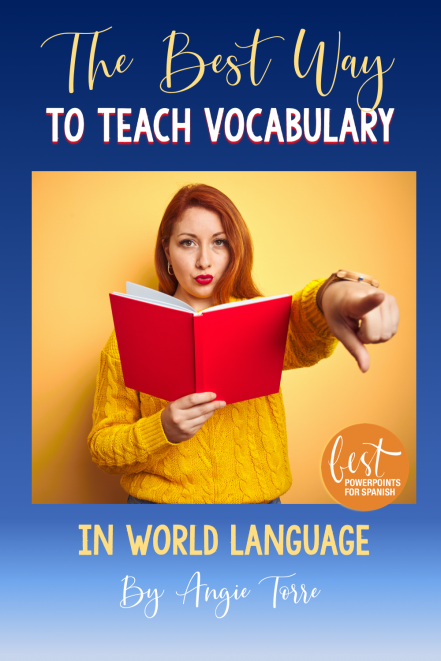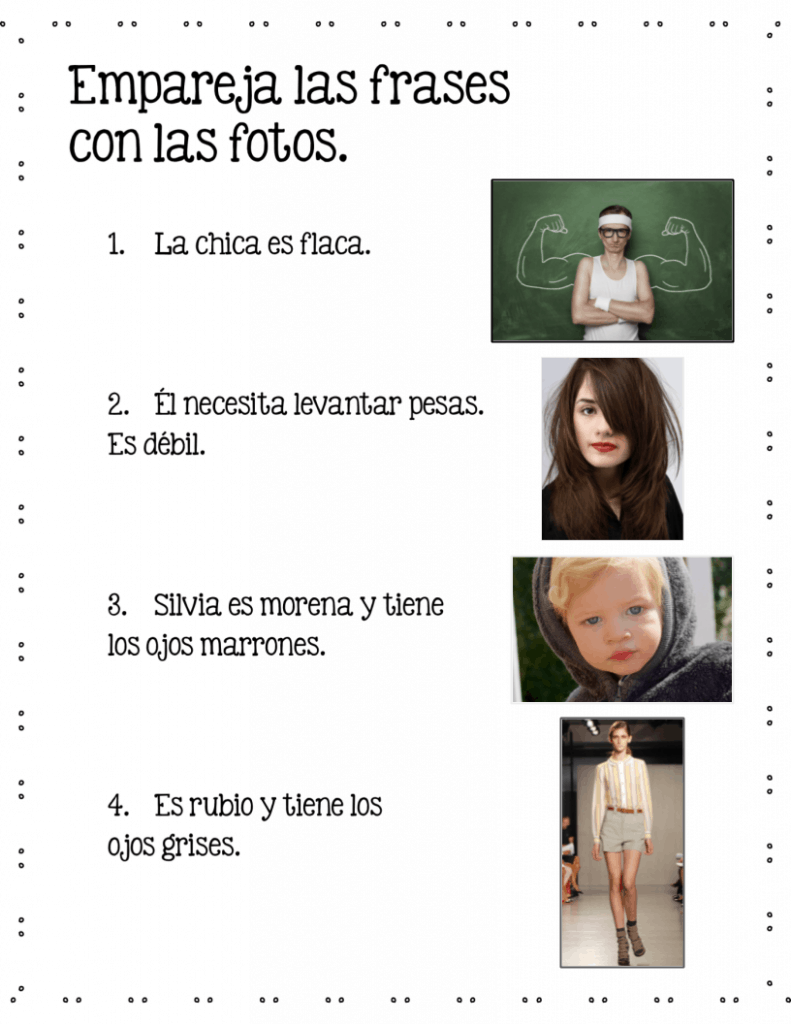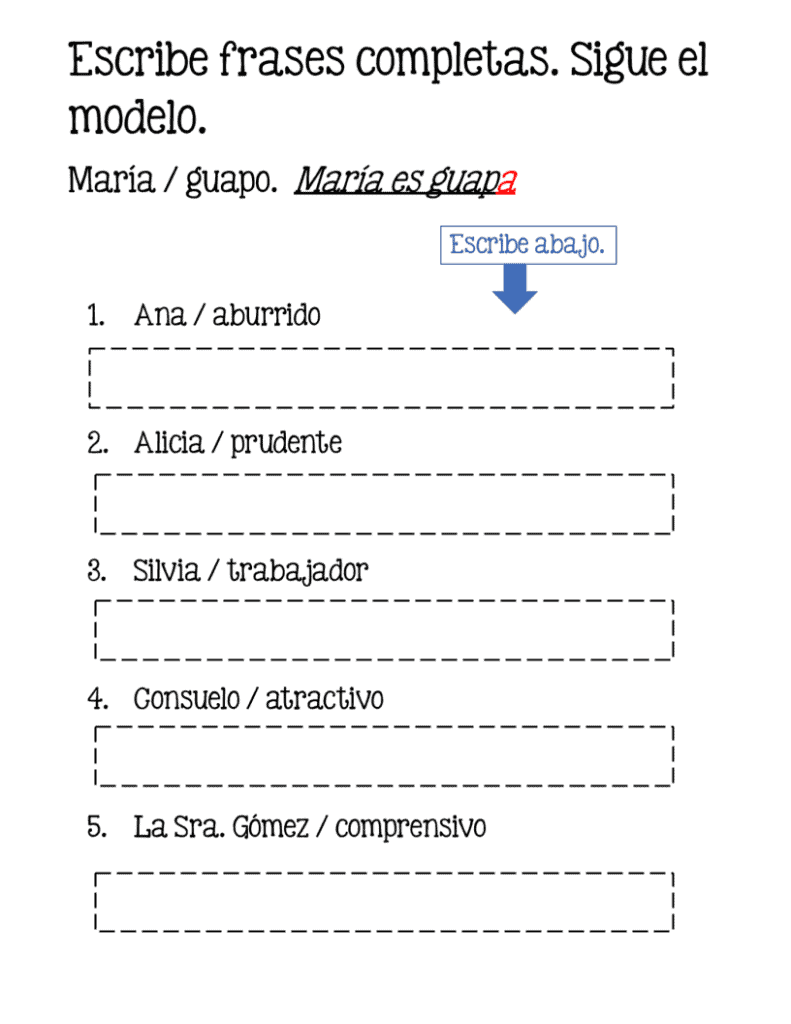The Best Way to Teach Vocabulary in World Language
What’s the best way to teach vocabulary? A million ways. OK, that’s hyperbole. But, what I mean is, the more different ways you teach it, the better, because more activities equals more repetition, and variety adds interest. Bored students will not learn.

How many times IN CONTEXT does a person have to see or hear a word before it becomes part of their working vocabulary? I’ve heard 72 times in the past but let’s just say, many, many times.
Suppose I want my students to be able to describe themselves and others. I show them this FABULOUS Los adjetivos PowerPoint with amazing visuals, words in context, and practices. Now students are ready to describe someone, right?
Wrong! They have not even begun to have enough comprehensible input to produce. Next, I show them my Spanish Adjectives Video with native speakers, subtitles and pop-in images to aid in comprehension. After watching the video, students work on activities that recycle the language. We’re still in the recognition, comprehension stage. No one’s ready to produce yet.
Next, (and not in this particular order), I act out the adjectives with the students. It’s fun to come up with different gestures for each one. Sometimes, if the list is long (I try to only teach 7-10 a day) I put students in pairs and have them take turns alternately saying and acting out the words AFTER we have acted out the words as a class.
Then, I tell a STORY using TPR strategies in order to repeat the adjectives in context. After acting out the story with the students, asking intermittent questions during the narrative, students complete activities which, once again, recycle the vocabulary.
Next, I ask for volunteers to describe students in the class.
Then, we play the Dating Game, an extremely effective CI tool. This activity is guaranteed to get students (and the teacher) laughing uproariously. I describe different popular icons and students have to choose whom they will date. They cannot abstain. After every icon has been described and all have voted, I reveal whom they have chosen. (There’s an additional description that makes it hilarious.)
Now can they produce? Yes, a little. With help. Now is when I ease them into production but only after beginning with recognition. Google Drive Activities are awesome tools for comprehensible input because students read grammatically correct statements and move the images to match them. And students love them, so expect 100% student participation.
The image below shows how students must read the sentences and then move the images to the corresponding sentence.

FINALLY, when students have had enough input, they begin to write sentences, but with aids. As you can see in the image below, students are given the subject and adjective and only have to provide the correct form of the verb and adjective.

Some follow-up production activities are:
- Interactive Notebook Activities in which students describe the people in the pictures and draw pictures based on the descriptions
- Listening activities in which students listen to the description and draw what they hear
- Paired Activities in which students ask and answer questions based on pictures
- PowerPoint with photos of your students that students describe
- Homework in which students describe family members or famous people.
- Homework in which students write the opposite description
Let’s start over with stem-changing verbs.
Wait! That’s grammar, right? Yes and no. Grammar is acquired the same way vocabulary is, through comprehensible input.
I DO formally teach the grammar first because I want my students to be literate as well as fluent and I want to connect the conscious mind to the unconscious. After I teach the grammar concept, though, I provide the same CI as I do for vocabulary, so students hear or see the words in context repeatedly because, ultimately, it is through input that they acquire the language.
Here’s a condensed version because I know your time is limited.
- Teach the concept with a PowerPoint and Activities.
- Act out the verbs with students.
- Tell a TPR Story.
- Show a VIDEO with a story that uses tons of Stem-changing Verbs.
- Google Drive Game
- Production: Paired and Group Activities
So, what’s the best way to teach vocabulary?
With a variety of strategies and activities that provide sufficient amount of comprehensible input to enable students to produce. Whenever my students are struggling to communicate, I know it is because I have rushed the lesson and not provided enough input. Having enough tools in my teacher toolbox allows me to give the necessary amount of repetition in context.
Don’t want to do all the work yourself? Here’s a FREE LESSON ON ADJECTIVES with bell work, homework, and student handouts.
Need some background on CI? Here’s a post by SpanishMama on the subject.
Click on the following link for more ideas on How to Add the Best Comprehensible Input.
Would you like to get teaching tips and freebies in your email? If so, click on Best PowerPoints for Spanish and French and scroll to the bottom. For signing up you get a FREE 122-slide PowerPoint on regular verbs and infinitives.
Are you following my store? Be the first to see new products and updates on existing products. Click on MY STORE to follow me.

